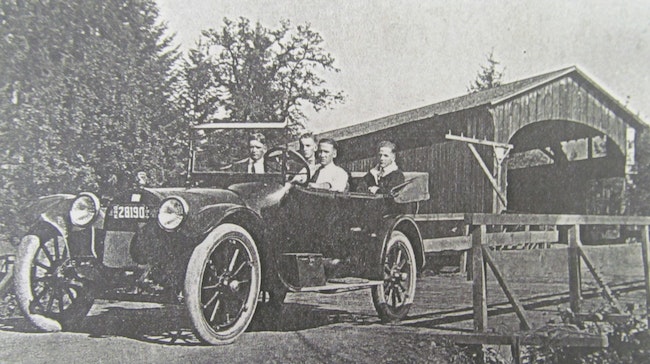 The Mary White Bridge – the original – built in 1929 and torn down 1964. PHOTO COURTESY OF COTTAGE GROVE MUSEUM
The Mary White Bridge – the original – built in 1929 and torn down 1964. PHOTO COURTESY OF COTTAGE GROVE MUSEUM
A story on the Dorena Covered Bridge, which appeared in this column, prompted a reader to contact me and share a treasure. The gift was a complete set of note cards showing Oregon’s covered bridges by the late Catharine Pratt Filmer, better known as “The Covered Bridge Lady.” Contained in the box are sets of cards organized by location. The first card in each set is a tour map showing the bridges’ locations, followed by the note cards showing her drawings of the covered bridges themselves, 61 in all along with nine different tour maps. Some of the bridges depicted are gone with the wind, the rest stand today in part due to Filmer’s relentless championing for saving them.
Catherine Filmer’s dream from an early age was to be an art teacher. She had a talent as a child for drawing and sketching. When she told her parents of her plans, they let her know that they couldn’t afford to send her to art school, but told her if it really meant that much to her she’d find a way to put herself through. This is somewhat surprising considering her mother was a suffragette and teacher herself; seems like they would have been more supportive, but in view of the times art must have seemed a poor outlook to support a young woman.
 Catharine Filmer, “The Covered Bridge Lady,” 1903 -1989.
Catharine Filmer, “The Covered Bridge Lady,” 1903 -1989.
Following her high school graduation Filmer apprenticed as a librarian, in part due to her fondness for books. After two years she discovered that to love reading books is not the same as handling them on a daily basis. She then enrolled in kindergarten training school and on completion took a job in New Jersey working with students with severe special needs. In that role she rose to be principal of several institutions in Washington, D.C., and Indiana, before taking a job in Maryland during the depression. There, she worked as a teacher, occupational therapist, and eventually served as principal for the district training school, serving students with profound needs for 14 years.
Throughout this time of serving what was then called mentally retarded students, she never forgot her desire to teach art. After WWII Filmer made a bold but risky decision — she left an upwardly successful career path to take the plunge of following her heart. Filmer enrolled in the arts education program at Temple University in Philadelphia and while completing her masters there, she taught at the Tyler School of Fine Arts on campus.
Filmer possessed one of those restless yearning for new experiences, in a 1980 newspaper article (Register Guard) she described herself thusly, “I have a mania for wanting to learn how to do things and I read a lot.” This spirit moved her to do something bold. In her words, “My friends at Tyler told me I was the only one crazy enough to give up everything and head out to the West Coast.” After a year’s stop in Coolidge, Ariz., she decided the heat wasn’t for her and landed in Cottage Grove in 1958, seeking a cooler climate. Drawn by an art teacher job at Cottage Grove High School, Filmer plunged into her new community.
Determined to provide the best experiences for her students, she sought out and fought for the best equipment and art supplies for their use. She was constantly attending conferences and pouring over industry publications to see what was new in the arts and crafts world. While considered a strict and no-nonsense teacher, her obvious love of students and the arts won them over. Filmer designed her program with enough variety so students could take classes with her for four years and get something new each time. The art room at CGHS had high walls. A friend that knew her well told how each year Filmer would encourage her students to create murals around all four sides of the upper walls. “They were beautiful and remained up for the year. The next year, a new group of students created their ideas, painting the walls anew.”
Barbara Gant knew Catharine primarily from seeing her interact with youth at First Presbyterian Church where Filmer was a member and an elder. Serving as group leader for the church youth when they went on the annual snow retreat to Santiam Lodge, Gant was happy to have Filmer along as a counselor. “She was invaluable and I always counted on her abilities. Catharine had the uncanny skill to watch a group functioning and be aware of the ones that didn’t quite fit in, or needed extra encouragement to join the activities. Filmer also taught art classes at the church, part of citywide Wednesday afternoon program for youth. She often team-taught with then-minister, and no mean artist himself, Rev. Hugh Peniston. “The art that came out of those classes and covered the church walls was simply wonderful,” Gant said.
In describing Catharine’s teaching abilities, Gant shared, “She was a wonderful teacher, have you watched a student not happy with what they were doing and crumple up their paper saying ‘It’s no good!’ Catherine would gently say to the student, ‘Let’s look at what you have done. What can you do to make it better or into something else? Life does not always turn out perfect and we must learn how to adapt and make something out of what we have done.’ What a life lesson! Art does not come easily to many, but Catharine encouraged students to develop their talents, even if they felt they had none.”
Besides her teaching activities, she signed on early to support the Cottage Grove Museum Committee. Filmer had the belief that historical museums were key to instilling local heritage into the community’s youth. On her retirement from the high school in 1970, Filmer turned into a juggernaut of varied activities. She was free to pursue her own artistic interests and lent her talents to groups in town. One which formed in 1972, was the “Past 45 Arts and Crafts Store.” This unique collective of senior artists and crafters had a storied run of 42 years and will be featured as a story in the future. Filmer not only contributed her art to the shelves of Past 45, she was a key organizer and helped with projects there.
Perhaps her strongest passion and claim to fame was her artistic mission to record and publicize the disappearing covered bridges of Oregon. The bug probably bit her in 1964 when Filmer heard that the nearby Mary White covered bridge was due to be torn down. “I dashed out and made some drawings, two days later it was completely gone.” This bridge was on London Road where it crossed the Coast Fork near where Riverstone Mobile Home park is today. Her drawing of this doomed bridge became a Christmas card that year and started her on a mission of drawing the covered bridges around Cottage Grove.
The Dorena Covered Bridge was next, then realizing that Cottage Grove had an unusual concentration of covered bridges she added the remaining five as cards and began selling them locally and at craft shows. With time to pursue her newfound love in retirement, she expanded to Lane County, and eventually captured all of those bridges, coming up with the guide cards to help people find and visit the bridges themselves. As she captured what Lane County had to offer in bridges, she cast her nets wider, taking in Linn, Douglas, and eventually all of the remaining 58 covered bridges in Oregon at that time.
Besides the art activities, she joined the “National Society for the Preservation of Covered Bridges,” then helped organize “The Covered Bridge Society of Oregon,” being the 13th charter member. In selling her covered bridge cards there were few bounds for the indefatigable Filmer. Eugene’s Saturday Market, coin and gun shows, craft shows, flea markets … and she also traveled widely in the state and to California to find shops willing to carry her covered bridge line. While at shows if anyone expressed an interest in covered bridges she would ask if they would like to join the Covered Bridge Society of Oregon. Affirmative responses were recorded on lists which she then forwarded to headquarters along with her remarks, “I obtained the names, now you get the members!” Not surprisingly she did grow the organization and was recognized not only by the group but by an appreciative Gov. Bob Straub, who sent her a letter commenting on her cards and efforts in bridge preservation.
Not being a one-trick pony, Filmer added a series of cards depicting Oregon roadside plants in her inimitable style. Some plants considered weeds, joined Deer Head Orchids and Camus in her selection. Her card business was not only a hobby, but she tried to make it an income-producing business. Each time she added a new series she went into a financial hole, but through hard work became solvent again each time.
 Three examples of Catharine Filmer’s “weed cards.”
Three examples of Catharine Filmer’s “weed cards.”
Another constant in Filmer’s life was her annual summer trip to Harrison, Maine to serve as jewelry making and arts teacher for the exclusive Pinecliffe girls camp. Founded in 1917, originally as a way to get vulnerable children out of cities and the reach of polio, this camp continues its character-building tradition for girls to this day. Known there as “Red” she was a dearly beloved member of the staff. Filmer would take a lengthy route to and from her summer pilgrimage to visit friends and take the opportunity to see new sights as well as learn new skills each trip. On her final jaunt in 1989 she went out of her way to Tennessee to take lessons on the Colonial Walking Spinning Wheel, something she had always wanted to try.
Working at Pinecliffe for nearly 30 summers, Filmer had the opportunity to teach children and nieces of former campers. One woman, who was so touched by attending her classes as a youth, journeyed to Cottage Grove because she wanted to see the place Catharine had called home. She later sent pictures of the memorial built at Pinecliffe in the form of a small covered bridge, a tribute to her long service and love she generated there.
Catharine Flimer lost her life in a tragic fire on Dec. 27, 1989, when McCoy’s Pharmacy building, where she had her apartment, burned in a suspected arson fire. The blaze not only snuffed a vibrant flame of creativity it also destroyed nearly half a block of the historic district. While the Pharmacy was rebuilt, a gaping hole along Main Street still bears witness to the tragedy. A small plaque remembers Filmer on the mural wall that hides the ruins.
At her memorial on Jan. 13, 1990, First Presbyterian Church was filled to overflowing with friends, former students, and people touched by this gifted and generous soul. The remembrances and tributes shared went on for some time. As a final tribute, the Covered Bridge Society of Oregon had this to say, “There is no doubt this feisty, straightforward thinking and speaking little lady (she was barely 5 feet tall) will be remembered and missed by many people for years to come. Rest in Peace, Catharine.”
Email: [email protected]








